ESC300 STEM Pedagogy: Contemporary Indigenous STEM Solutions
VerifiedAdded on 2023/06/03
|8
|1464
|160
Report
AI Summary
This report delves into the integration of Indigenous perspectives within STEM education, addressing the underrepresentation of Indigenous students in STEM fields in Australia. It highlights strategies for teachers to incorporate Indigenous knowledge into STEM programs, emphasizing the importance of prior knowledge and student motivation. The report includes a visualization of Indigenous technological solutions, a flowchart describing the STEM project process, and an outline of the fair test process in integrating STEM programs, covering planning, investigation, and results. It further evaluates key skills gained from STEM programs and stresses the importance of sustainability, curriculum reforms, and policies for implementing Indigenous STEM initiatives. The document concludes by advocating for continued efforts to include Indigenous students in STEM, encouraging teachers to develop necessary skills for preparing students for STEM programs. Desklib provides access to this document, along with a wealth of resources including past papers and solved assignments, to support students' learning journeys.
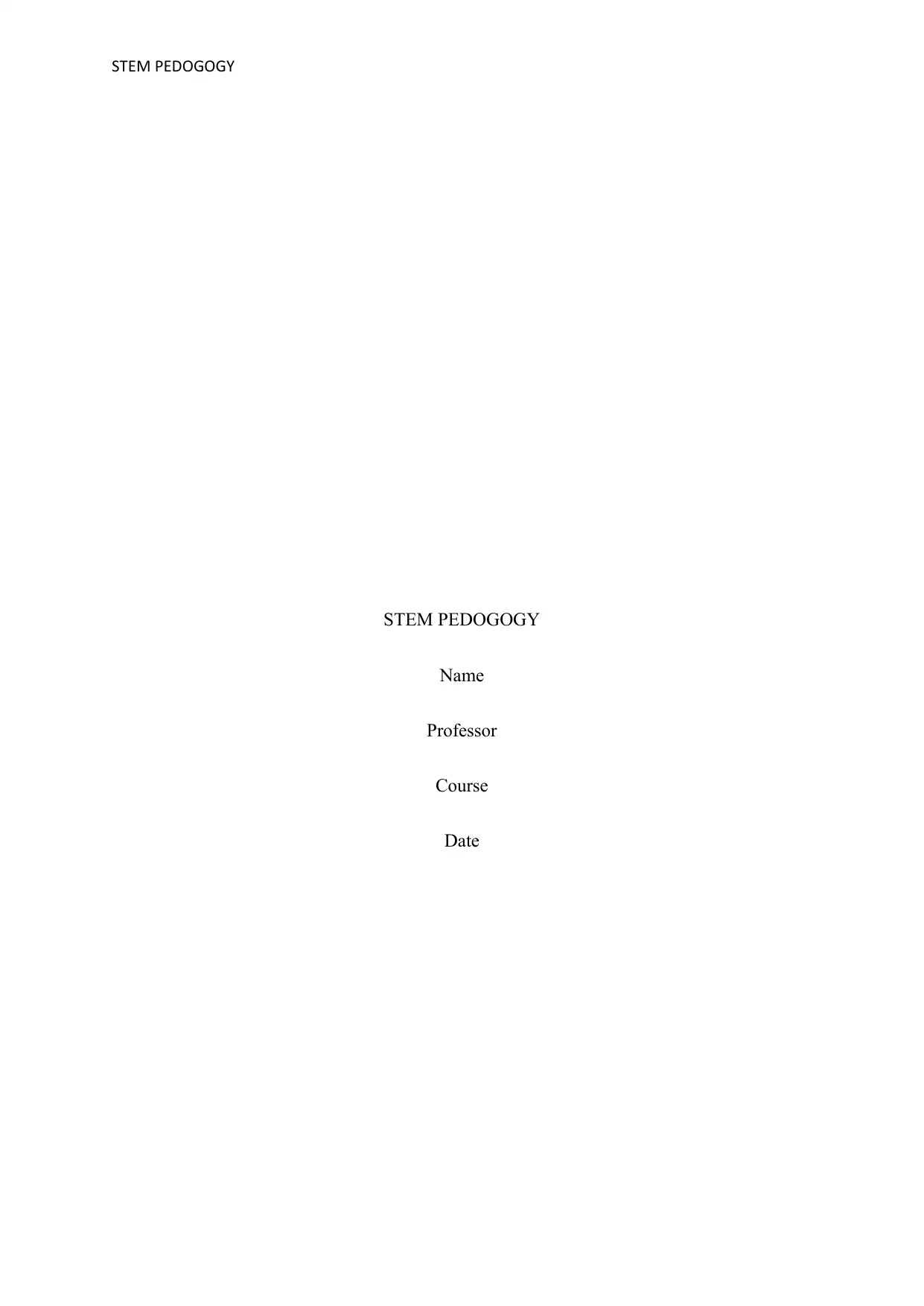
STEM PEDOGOGY
STEM PEDOGOGY
Name
Professor
Course
Date
STEM PEDOGOGY
Name
Professor
Course
Date
Paraphrase This Document
Need a fresh take? Get an instant paraphrase of this document with our AI Paraphraser
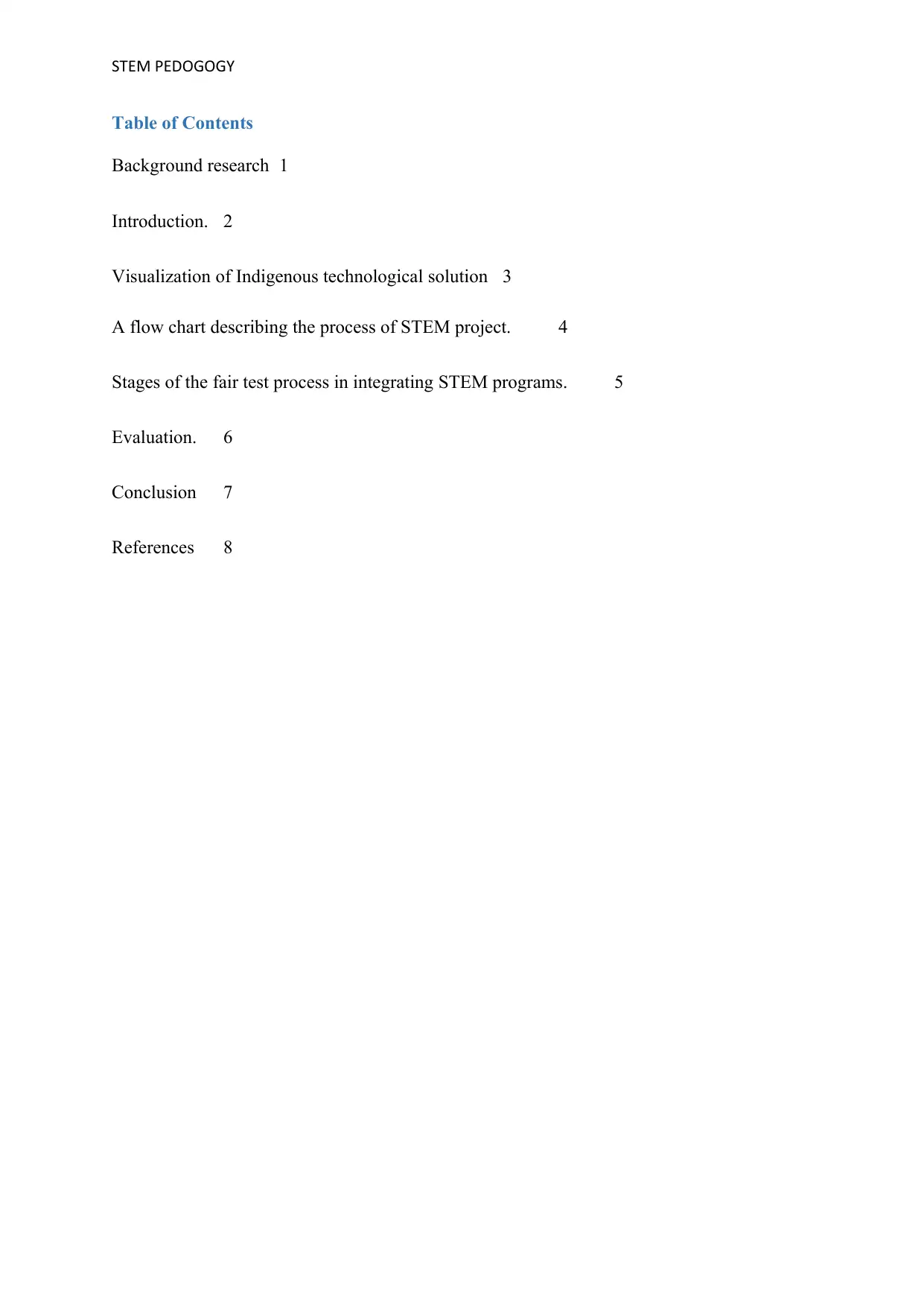
STEM PEDOGOGY
Table of Contents
Background research 1
Introduction. 2
Visualization of Indigenous technological solution 3
A flow chart describing the process of STEM project. 4
Stages of the fair test process in integrating STEM programs. 5
Evaluation. 6
Conclusion 7
References 8
Table of Contents
Background research 1
Introduction. 2
Visualization of Indigenous technological solution 3
A flow chart describing the process of STEM project. 4
Stages of the fair test process in integrating STEM programs. 5
Evaluation. 6
Conclusion 7
References 8
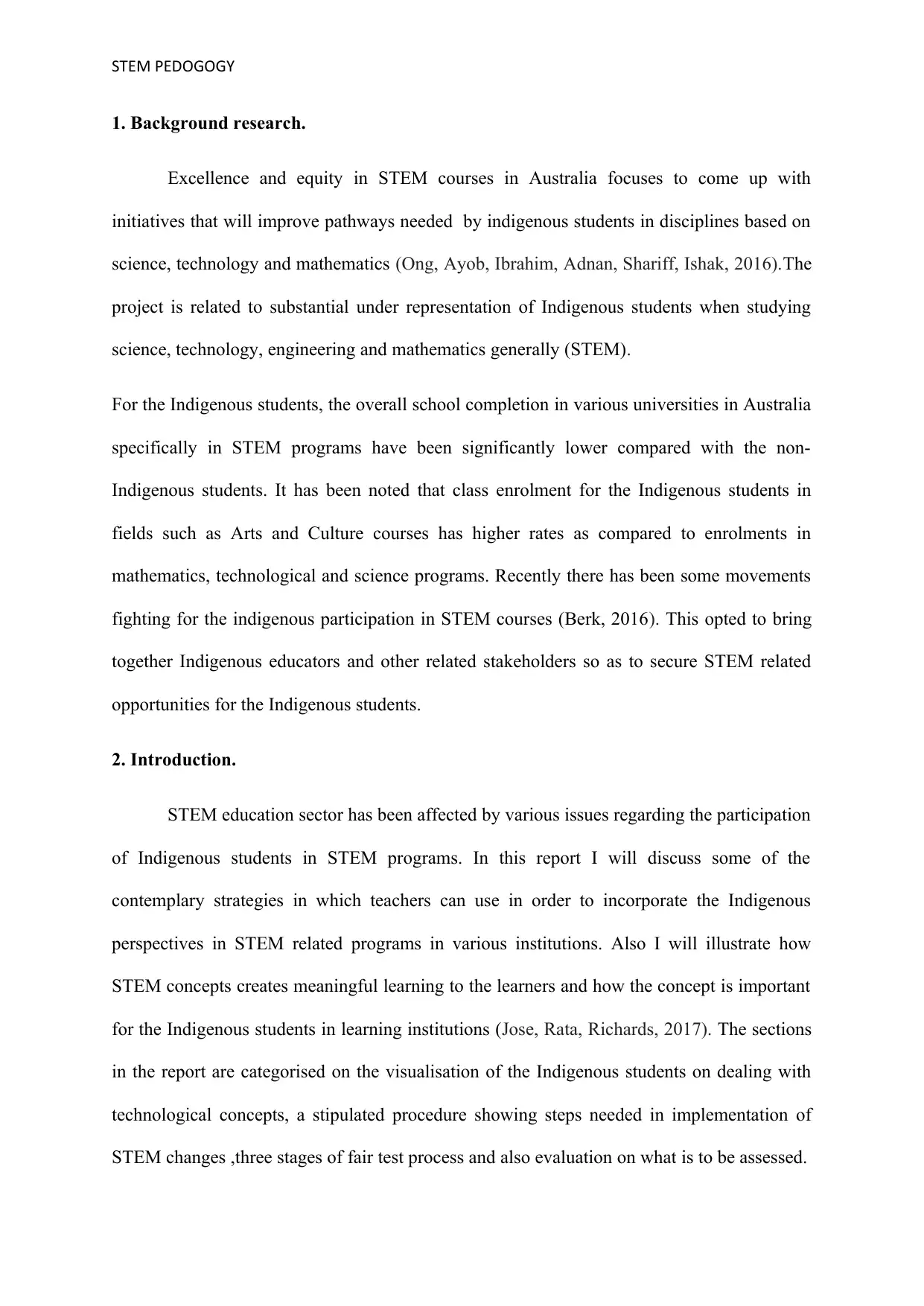
STEM PEDOGOGY
1. Background research.
Excellence and equity in STEM courses in Australia focuses to come up with
initiatives that will improve pathways needed by indigenous students in disciplines based on
science, technology and mathematics (Ong, Ayob, Ibrahim, Adnan, Shariff, Ishak, 2016).The
project is related to substantial under representation of Indigenous students when studying
science, technology, engineering and mathematics generally (STEM).
For the Indigenous students, the overall school completion in various universities in Australia
specifically in STEM programs have been significantly lower compared with the non-
Indigenous students. It has been noted that class enrolment for the Indigenous students in
fields such as Arts and Culture courses has higher rates as compared to enrolments in
mathematics, technological and science programs. Recently there has been some movements
fighting for the indigenous participation in STEM courses (Berk, 2016). This opted to bring
together Indigenous educators and other related stakeholders so as to secure STEM related
opportunities for the Indigenous students.
2. Introduction.
STEM education sector has been affected by various issues regarding the participation
of Indigenous students in STEM programs. In this report I will discuss some of the
contemplary strategies in which teachers can use in order to incorporate the Indigenous
perspectives in STEM related programs in various institutions. Also I will illustrate how
STEM concepts creates meaningful learning to the learners and how the concept is important
for the Indigenous students in learning institutions (Jose, Rata, Richards, 2017). The sections
in the report are categorised on the visualisation of the Indigenous students on dealing with
technological concepts, a stipulated procedure showing steps needed in implementation of
STEM changes ,three stages of fair test process and also evaluation on what is to be assessed.
1. Background research.
Excellence and equity in STEM courses in Australia focuses to come up with
initiatives that will improve pathways needed by indigenous students in disciplines based on
science, technology and mathematics (Ong, Ayob, Ibrahim, Adnan, Shariff, Ishak, 2016).The
project is related to substantial under representation of Indigenous students when studying
science, technology, engineering and mathematics generally (STEM).
For the Indigenous students, the overall school completion in various universities in Australia
specifically in STEM programs have been significantly lower compared with the non-
Indigenous students. It has been noted that class enrolment for the Indigenous students in
fields such as Arts and Culture courses has higher rates as compared to enrolments in
mathematics, technological and science programs. Recently there has been some movements
fighting for the indigenous participation in STEM courses (Berk, 2016). This opted to bring
together Indigenous educators and other related stakeholders so as to secure STEM related
opportunities for the Indigenous students.
2. Introduction.
STEM education sector has been affected by various issues regarding the participation
of Indigenous students in STEM programs. In this report I will discuss some of the
contemplary strategies in which teachers can use in order to incorporate the Indigenous
perspectives in STEM related programs in various institutions. Also I will illustrate how
STEM concepts creates meaningful learning to the learners and how the concept is important
for the Indigenous students in learning institutions (Jose, Rata, Richards, 2017). The sections
in the report are categorised on the visualisation of the Indigenous students on dealing with
technological concepts, a stipulated procedure showing steps needed in implementation of
STEM changes ,three stages of fair test process and also evaluation on what is to be assessed.
⊘ This is a preview!⊘
Do you want full access?
Subscribe today to unlock all pages.

Trusted by 1+ million students worldwide
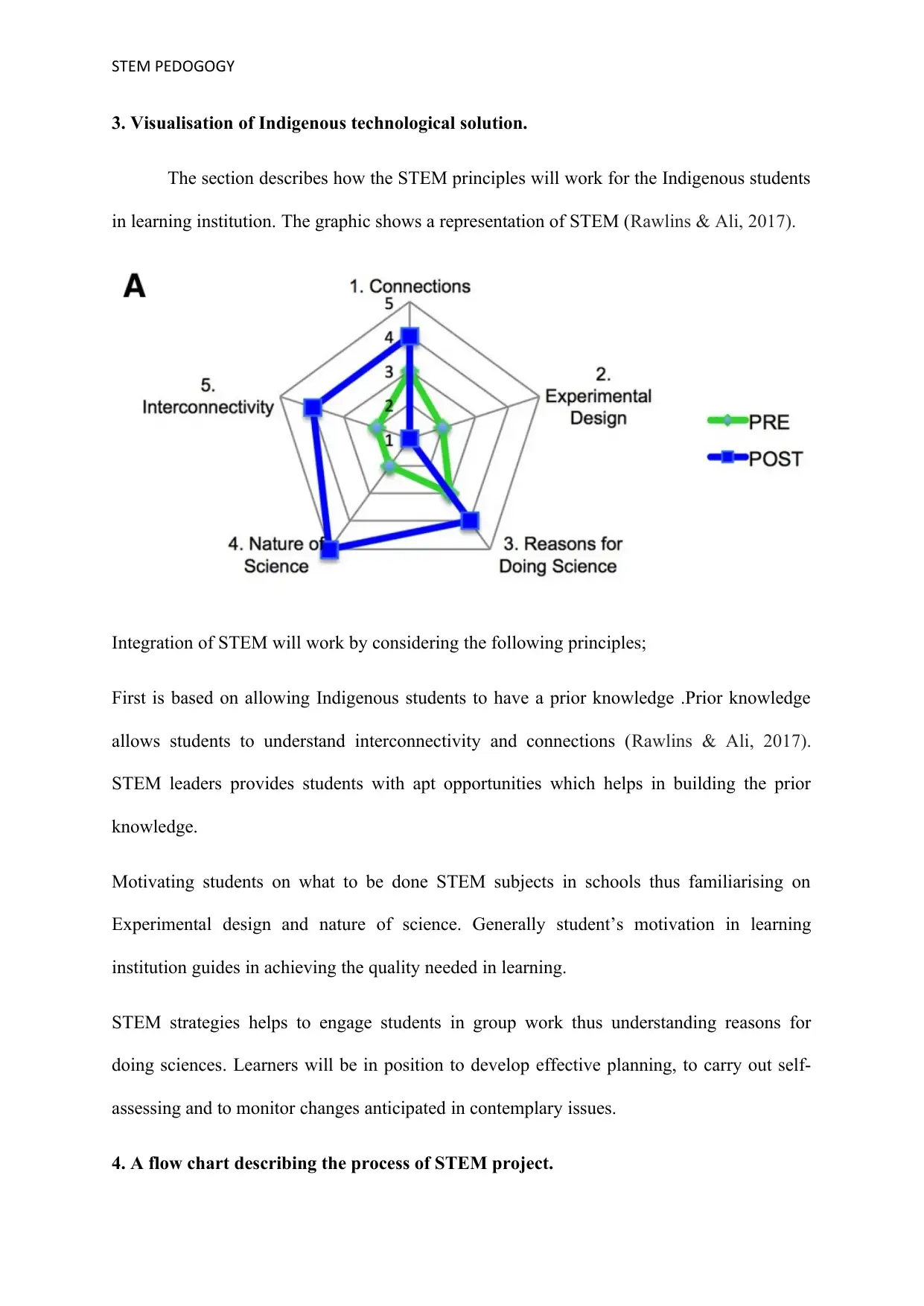
STEM PEDOGOGY
3. Visualisation of Indigenous technological solution.
The section describes how the STEM principles will work for the Indigenous students
in learning institution. The graphic shows a representation of STEM (Rawlins & Ali, 2017).
Integration of STEM will work by considering the following principles;
First is based on allowing Indigenous students to have a prior knowledge .Prior knowledge
allows students to understand interconnectivity and connections (Rawlins & Ali, 2017).
STEM leaders provides students with apt opportunities which helps in building the prior
knowledge.
Motivating students on what to be done STEM subjects in schools thus familiarising on
Experimental design and nature of science. Generally student’s motivation in learning
institution guides in achieving the quality needed in learning.
STEM strategies helps to engage students in group work thus understanding reasons for
doing sciences. Learners will be in position to develop effective planning, to carry out self-
assessing and to monitor changes anticipated in contemplary issues.
4. A flow chart describing the process of STEM project.
3. Visualisation of Indigenous technological solution.
The section describes how the STEM principles will work for the Indigenous students
in learning institution. The graphic shows a representation of STEM (Rawlins & Ali, 2017).
Integration of STEM will work by considering the following principles;
First is based on allowing Indigenous students to have a prior knowledge .Prior knowledge
allows students to understand interconnectivity and connections (Rawlins & Ali, 2017).
STEM leaders provides students with apt opportunities which helps in building the prior
knowledge.
Motivating students on what to be done STEM subjects in schools thus familiarising on
Experimental design and nature of science. Generally student’s motivation in learning
institution guides in achieving the quality needed in learning.
STEM strategies helps to engage students in group work thus understanding reasons for
doing sciences. Learners will be in position to develop effective planning, to carry out self-
assessing and to monitor changes anticipated in contemplary issues.
4. A flow chart describing the process of STEM project.
Paraphrase This Document
Need a fresh take? Get an instant paraphrase of this document with our AI Paraphraser
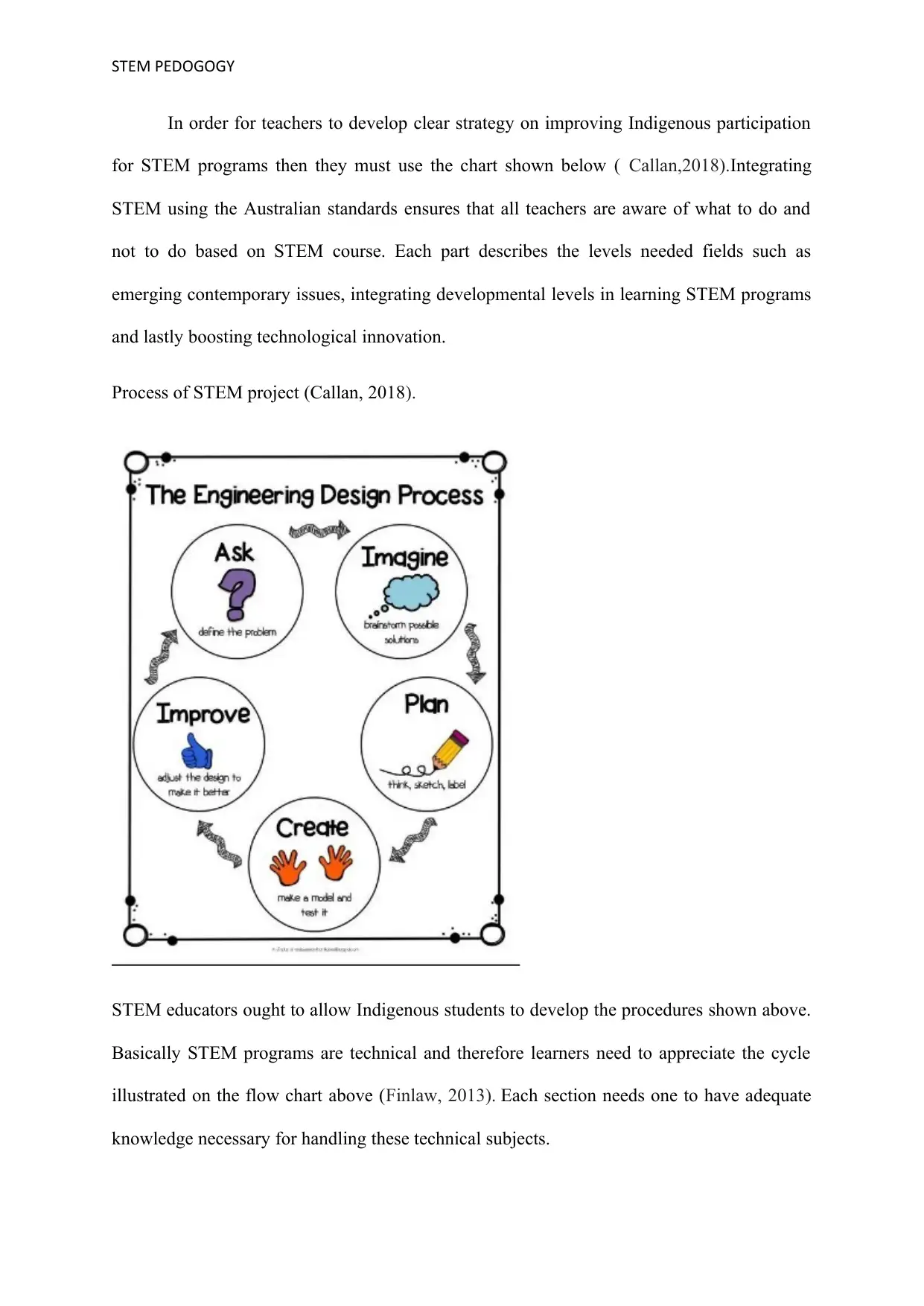
STEM PEDOGOGY
In order for teachers to develop clear strategy on improving Indigenous participation
for STEM programs then they must use the chart shown below ( Callan,2018).Integrating
STEM using the Australian standards ensures that all teachers are aware of what to do and
not to do based on STEM course. Each part describes the levels needed fields such as
emerging contemporary issues, integrating developmental levels in learning STEM programs
and lastly boosting technological innovation.
Process of STEM project (Callan, 2018).
STEM educators ought to allow Indigenous students to develop the procedures shown above.
Basically STEM programs are technical and therefore learners need to appreciate the cycle
illustrated on the flow chart above (Finlaw, 2013). Each section needs one to have adequate
knowledge necessary for handling these technical subjects.
In order for teachers to develop clear strategy on improving Indigenous participation
for STEM programs then they must use the chart shown below ( Callan,2018).Integrating
STEM using the Australian standards ensures that all teachers are aware of what to do and
not to do based on STEM course. Each part describes the levels needed fields such as
emerging contemporary issues, integrating developmental levels in learning STEM programs
and lastly boosting technological innovation.
Process of STEM project (Callan, 2018).
STEM educators ought to allow Indigenous students to develop the procedures shown above.
Basically STEM programs are technical and therefore learners need to appreciate the cycle
illustrated on the flow chart above (Finlaw, 2013). Each section needs one to have adequate
knowledge necessary for handling these technical subjects.
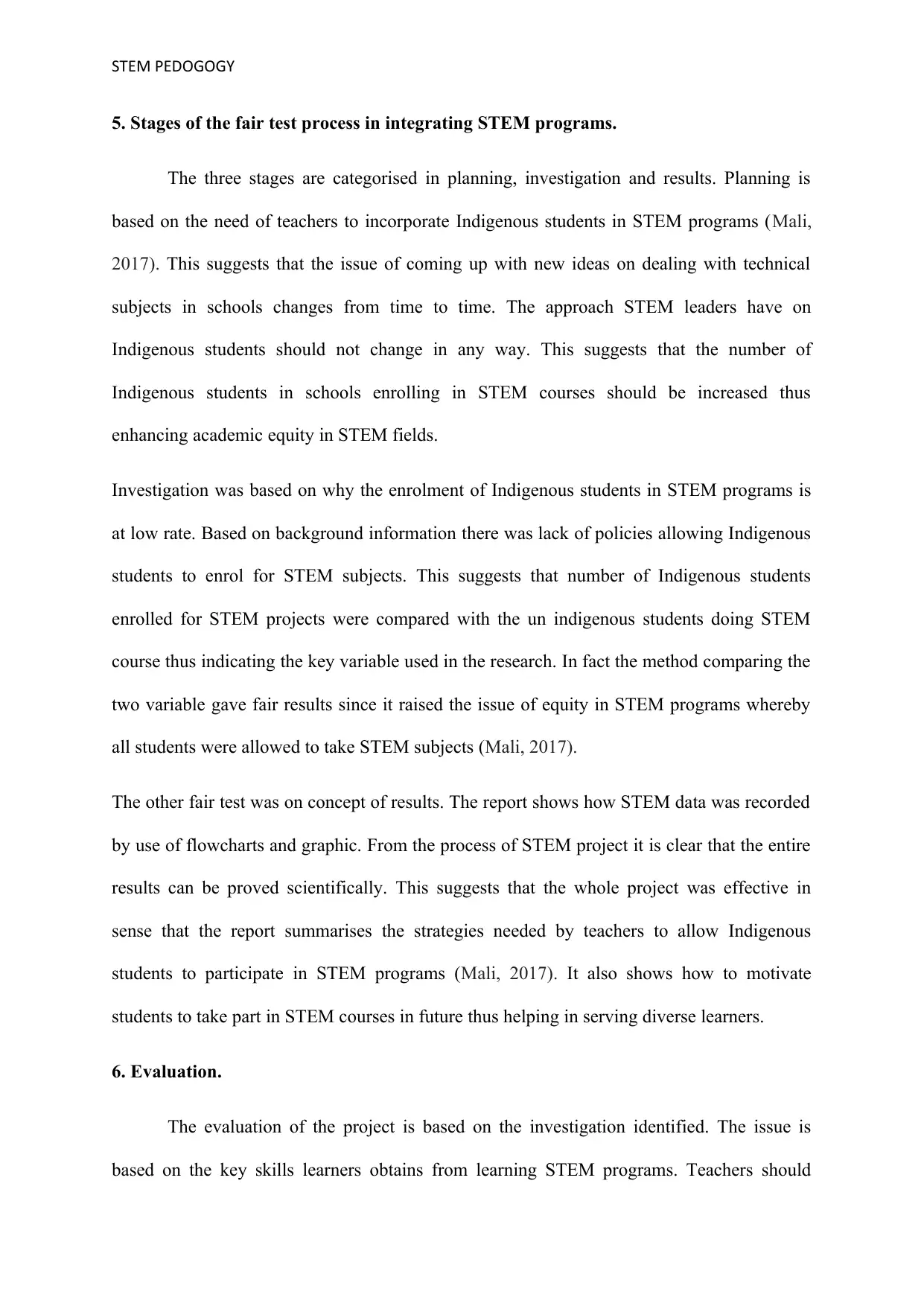
STEM PEDOGOGY
5. Stages of the fair test process in integrating STEM programs.
The three stages are categorised in planning, investigation and results. Planning is
based on the need of teachers to incorporate Indigenous students in STEM programs (Mali,
2017). This suggests that the issue of coming up with new ideas on dealing with technical
subjects in schools changes from time to time. The approach STEM leaders have on
Indigenous students should not change in any way. This suggests that the number of
Indigenous students in schools enrolling in STEM courses should be increased thus
enhancing academic equity in STEM fields.
Investigation was based on why the enrolment of Indigenous students in STEM programs is
at low rate. Based on background information there was lack of policies allowing Indigenous
students to enrol for STEM subjects. This suggests that number of Indigenous students
enrolled for STEM projects were compared with the un indigenous students doing STEM
course thus indicating the key variable used in the research. In fact the method comparing the
two variable gave fair results since it raised the issue of equity in STEM programs whereby
all students were allowed to take STEM subjects (Mali, 2017).
The other fair test was on concept of results. The report shows how STEM data was recorded
by use of flowcharts and graphic. From the process of STEM project it is clear that the entire
results can be proved scientifically. This suggests that the whole project was effective in
sense that the report summarises the strategies needed by teachers to allow Indigenous
students to participate in STEM programs (Mali, 2017). It also shows how to motivate
students to take part in STEM courses in future thus helping in serving diverse learners.
6. Evaluation.
The evaluation of the project is based on the investigation identified. The issue is
based on the key skills learners obtains from learning STEM programs. Teachers should
5. Stages of the fair test process in integrating STEM programs.
The three stages are categorised in planning, investigation and results. Planning is
based on the need of teachers to incorporate Indigenous students in STEM programs (Mali,
2017). This suggests that the issue of coming up with new ideas on dealing with technical
subjects in schools changes from time to time. The approach STEM leaders have on
Indigenous students should not change in any way. This suggests that the number of
Indigenous students in schools enrolling in STEM courses should be increased thus
enhancing academic equity in STEM fields.
Investigation was based on why the enrolment of Indigenous students in STEM programs is
at low rate. Based on background information there was lack of policies allowing Indigenous
students to enrol for STEM subjects. This suggests that number of Indigenous students
enrolled for STEM projects were compared with the un indigenous students doing STEM
course thus indicating the key variable used in the research. In fact the method comparing the
two variable gave fair results since it raised the issue of equity in STEM programs whereby
all students were allowed to take STEM subjects (Mali, 2017).
The other fair test was on concept of results. The report shows how STEM data was recorded
by use of flowcharts and graphic. From the process of STEM project it is clear that the entire
results can be proved scientifically. This suggests that the whole project was effective in
sense that the report summarises the strategies needed by teachers to allow Indigenous
students to participate in STEM programs (Mali, 2017). It also shows how to motivate
students to take part in STEM courses in future thus helping in serving diverse learners.
6. Evaluation.
The evaluation of the project is based on the investigation identified. The issue is
based on the key skills learners obtains from learning STEM programs. Teachers should
⊘ This is a preview!⊘
Do you want full access?
Subscribe today to unlock all pages.

Trusted by 1+ million students worldwide
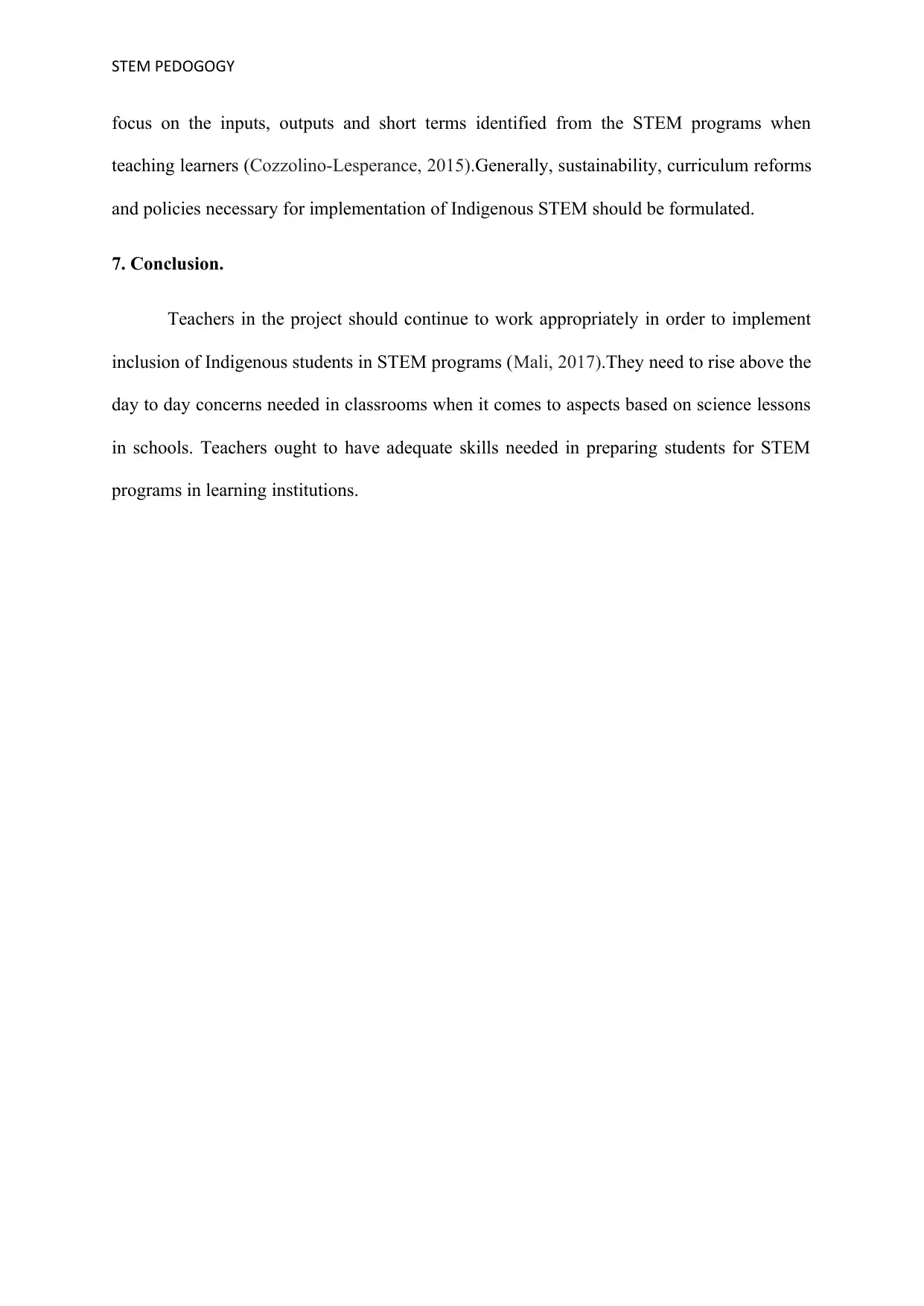
STEM PEDOGOGY
focus on the inputs, outputs and short terms identified from the STEM programs when
teaching learners (Cozzolino-Lesperance, 2015).Generally, sustainability, curriculum reforms
and policies necessary for implementation of Indigenous STEM should be formulated.
7. Conclusion.
Teachers in the project should continue to work appropriately in order to implement
inclusion of Indigenous students in STEM programs (Mali, 2017).They need to rise above the
day to day concerns needed in classrooms when it comes to aspects based on science lessons
in schools. Teachers ought to have adequate skills needed in preparing students for STEM
programs in learning institutions.
focus on the inputs, outputs and short terms identified from the STEM programs when
teaching learners (Cozzolino-Lesperance, 2015).Generally, sustainability, curriculum reforms
and policies necessary for implementation of Indigenous STEM should be formulated.
7. Conclusion.
Teachers in the project should continue to work appropriately in order to implement
inclusion of Indigenous students in STEM programs (Mali, 2017).They need to rise above the
day to day concerns needed in classrooms when it comes to aspects based on science lessons
in schools. Teachers ought to have adequate skills needed in preparing students for STEM
programs in learning institutions.
Paraphrase This Document
Need a fresh take? Get an instant paraphrase of this document with our AI Paraphraser
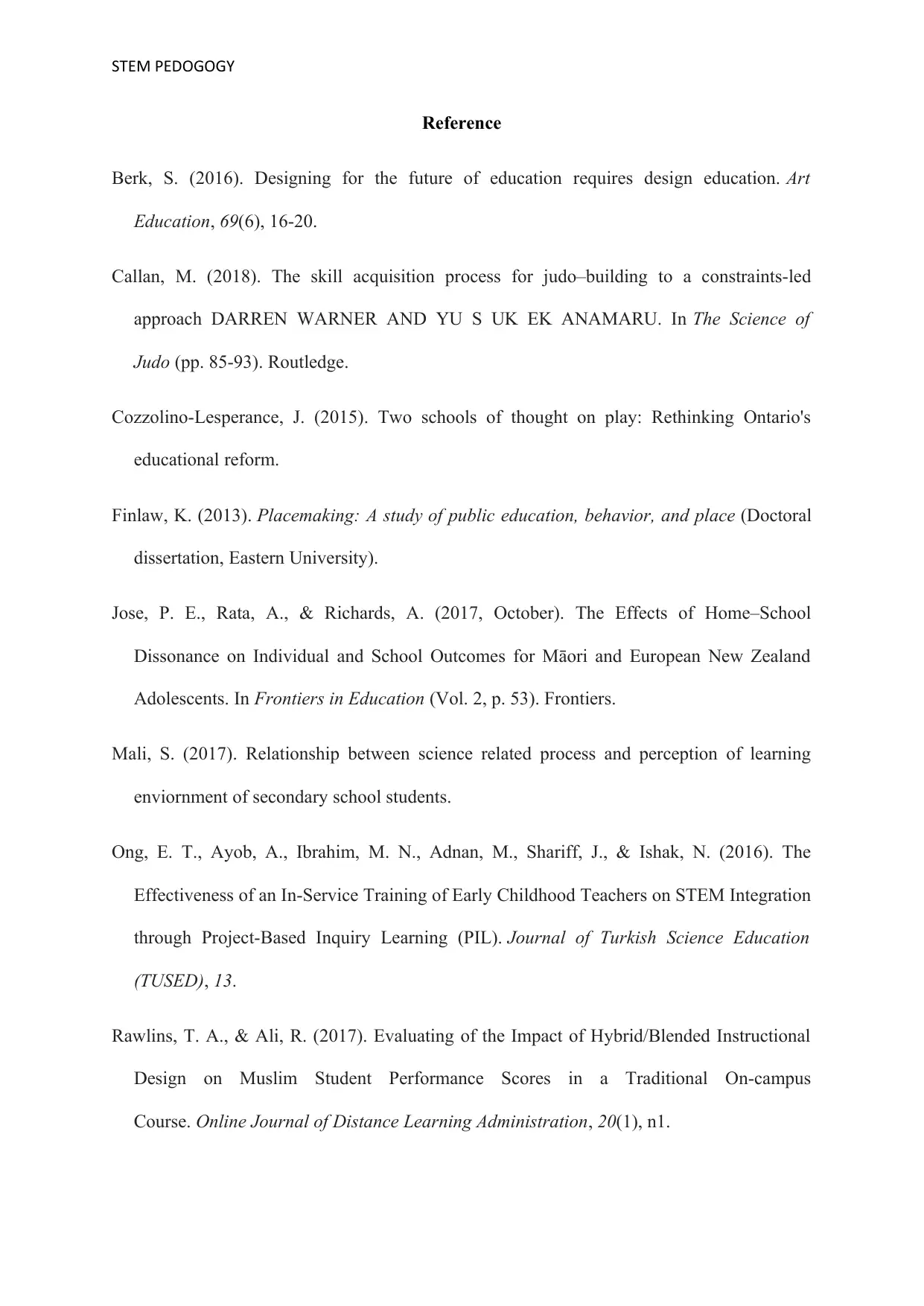
STEM PEDOGOGY
Reference
Berk, S. (2016). Designing for the future of education requires design education. Art
Education, 69(6), 16-20.
Callan, M. (2018). The skill acquisition process for judo–building to a constraints-led
approach DARREN WARNER AND YU S UK EK ANAMARU. In The Science of
Judo (pp. 85-93). Routledge.
Cozzolino-Lesperance, J. (2015). Two schools of thought on play: Rethinking Ontario's
educational reform.
Finlaw, K. (2013). Placemaking: A study of public education, behavior, and place (Doctoral
dissertation, Eastern University).
Jose, P. E., Rata, A., & Richards, A. (2017, October). The Effects of Home–School
Dissonance on Individual and School Outcomes for Māori and European New Zealand
Adolescents. In Frontiers in Education (Vol. 2, p. 53). Frontiers.
Mali, S. (2017). Relationship between science related process and perception of learning
enviornment of secondary school students.
Ong, E. T., Ayob, A., Ibrahim, M. N., Adnan, M., Shariff, J., & Ishak, N. (2016). The
Effectiveness of an In-Service Training of Early Childhood Teachers on STEM Integration
through Project-Based Inquiry Learning (PIL). Journal of Turkish Science Education
(TUSED), 13.
Rawlins, T. A., & Ali, R. (2017). Evaluating of the Impact of Hybrid/Blended Instructional
Design on Muslim Student Performance Scores in a Traditional On-campus
Course. Online Journal of Distance Learning Administration, 20(1), n1.
Reference
Berk, S. (2016). Designing for the future of education requires design education. Art
Education, 69(6), 16-20.
Callan, M. (2018). The skill acquisition process for judo–building to a constraints-led
approach DARREN WARNER AND YU S UK EK ANAMARU. In The Science of
Judo (pp. 85-93). Routledge.
Cozzolino-Lesperance, J. (2015). Two schools of thought on play: Rethinking Ontario's
educational reform.
Finlaw, K. (2013). Placemaking: A study of public education, behavior, and place (Doctoral
dissertation, Eastern University).
Jose, P. E., Rata, A., & Richards, A. (2017, October). The Effects of Home–School
Dissonance on Individual and School Outcomes for Māori and European New Zealand
Adolescents. In Frontiers in Education (Vol. 2, p. 53). Frontiers.
Mali, S. (2017). Relationship between science related process and perception of learning
enviornment of secondary school students.
Ong, E. T., Ayob, A., Ibrahim, M. N., Adnan, M., Shariff, J., & Ishak, N. (2016). The
Effectiveness of an In-Service Training of Early Childhood Teachers on STEM Integration
through Project-Based Inquiry Learning (PIL). Journal of Turkish Science Education
(TUSED), 13.
Rawlins, T. A., & Ali, R. (2017). Evaluating of the Impact of Hybrid/Blended Instructional
Design on Muslim Student Performance Scores in a Traditional On-campus
Course. Online Journal of Distance Learning Administration, 20(1), n1.
1 out of 8
Related Documents
Your All-in-One AI-Powered Toolkit for Academic Success.
+13062052269
info@desklib.com
Available 24*7 on WhatsApp / Email
![[object Object]](/_next/static/media/star-bottom.7253800d.svg)
Unlock your academic potential
Copyright © 2020–2025 A2Z Services. All Rights Reserved. Developed and managed by ZUCOL.




